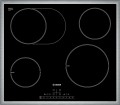Number of Hi-Light burners
The number of
Hi-Light burners in the design of the hob.
Hi-Light is an electric heater designed to eliminate the main disadvantages of solid plate burners (see above). Instead of a heating element, the “hi-lights” use a thin metal tape, and instead of a metal disc, glass-ceramic is used (see “Hob material”). Due to this, heaters of this type heat up and cool down noticeably faster than classic solid plate burners (although they are much more expensive).
Number of induction burners
The number of induction burners in the design of the hob.
A feature of such a burner is that it does not heat up by itself but transfers energy to the dishes using electromagnetic radiation. This radiation is safe for humans, and at the bottom of the dishes, it creates currents, providing heating. This format of operation provides several advantages over traditional heaters. Firstly, the burner instantly responds to a change in the operating mode — in this respect, induction heaters are similar to gas ones. Secondly, the surface of the hob (usually glass or glass-ceramic) practically does not heat up — except that part of the heat is transferred from the heated dishes; this has a positive effect on safety. Thirdly, induction burners are quite economical in terms of energy consumption. Among the disadvantages of induction heating, in addition to the high cost, we can mention that it only works with dishes made of thick steel or cast iron. Other metals on such a burner will heat up weakly, and glass, ceramics and other non-magnetic materials will not heat up at all. However, a lot of modern cookware is created specifically for compatibility with induction, which often has a corresponding designation on the bottom.
Frame
The presence of a metal
frame in the design of the hob. Such a frame can be located both around the entire perimeter of the device (in most classic models) and only on one side (usually in domino hobs, see "Design" for more details). The frame plays an aesthetic role, allowing you to optimally fit the hob into the overall design of the kitchen. However, it can also perform a very practical function: to retain liquids spilt onto the surface. On the other hand, such protection also has disadvantages: it can be quite difficult to clean dirt near the frame, and the liquid retained on the hob can burn, making cleaning even more difficult. So in terms of cleaning,
models without a frame are more convenient.
Dimensions (WxD)
General dimensions of the device in width and depth. Depth, in this case, refers to the distance from the leading edge to the trailing edge (when viewed from the user's side). Note that the external dimensions of the hobs are often larger than the dimensions for embedding (see below).

